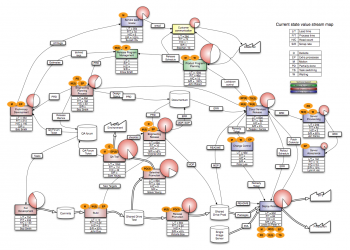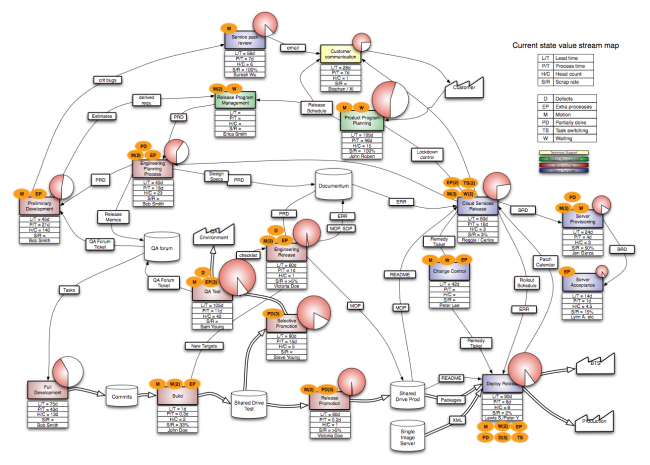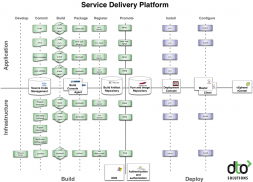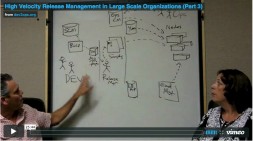Improving Flow: Fix the Handoffs to Remove Your Worst Bottlenecks
Alex Honor /
Minimizing time to market and getting faster feedback from customers are primary concern for businesses who want to stay competitive. You need to be able to go from a business idea to a customer-facing running service as quickly, reliably, and effortlessly as possible. This as a flow of work that crosses many organizational silos.
Where does this flow often bog down? Handoffs. Whether the handoffs are within a team (e.g. Dev to Dev) or between teams (e.g. Dev to Ops), there is always the need to pass work from one stage of the lifecycle to the next.
At DTO Solutions, our clients are often already aware that they have flow problems when they ask us to for help. When we use techniques like Value-Stream Mapping to learn how the work flows, handoff problems are prominent forms of waste that jump off of the page. The diagram below uses pie charts to highlight the relative time lost due to difficult handoffs during the product life cycle.
What are common reasons for difficult handoffs?
- Conversations, email, multitudinous wikis, spreadsheets, and trouble ticket systems are used to describe, in human language, how to process work. Words are open to interpretation and documents often lag behind current operating procedure. Just imagine being the person planning or performing the work and traversing the information across these various tools.
- Software product artifacts differ between stages of the process. Sometimes software resides in a directory on a file share and other times it’s a TAR file. The software handoff may contain the same bits, but must be handled or converted by the downstream stage of the software delivery process.
- Work can be considered “done” yet be unfinished or in a non-working state.The lack of a test or means to verify the work was done correctly often leads to products not ready for the next person down the line. This can leave the person in the downstream stage with what is essentially scrap that has to be rejected or redone.
- Ad hoc procedures or loose scripting often lead to different approaches and implementations for what should be standard operating procedure. This can lead to silo-specific utilities with different levels of quality and testing.
Handoff problems affect organizations, both big and small. Obviously, one answer to solving handoff problems is to minimize them. But if you are in an organization larger than just a handful of people, that just isn’t a realistic option. To decrease time to market and enable fast feedback, you are going to have to roll up your sleeves to solve the handoff problems.
Where are good places to start making handoffs smoother?
Here are a few of the top fixes that we find important for solving handoff problems at their source:
- Consistent packaging
- The most direct way to simplify software handoffs between Dev and Ops is using a common system package format like RPM or Debian. Using a system package format also aligns application deployment and system provisioning practices.
- Encapsulated procedures
- Rather than loose scripts or team-specific ones, choose a framework that enables modular automation. Using a modular approach results in a shared tool box of utilities and captured process.
- Converting information flows into artifact flows
- Rather than rely on human read text as the product for the downstream process to handle, formalize it as an automation product and build on the idea of encapsulated procedures.
- Procedure verification tests
- Verification testing should not be dominated by manual checks described in text documents. Building on the idea of converting information into artifacts, implement verification using a test automation framework. Most apps have some level of testing to verify functionality. Build a testing framework to verify an operation (eg, software deployment) procedure was successful by executing an automated test.
In subsequent posts, we’ll address each one of these fixes.





















































